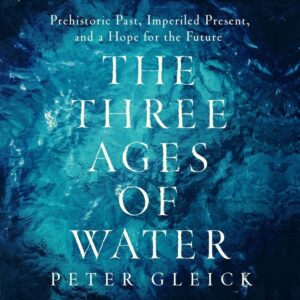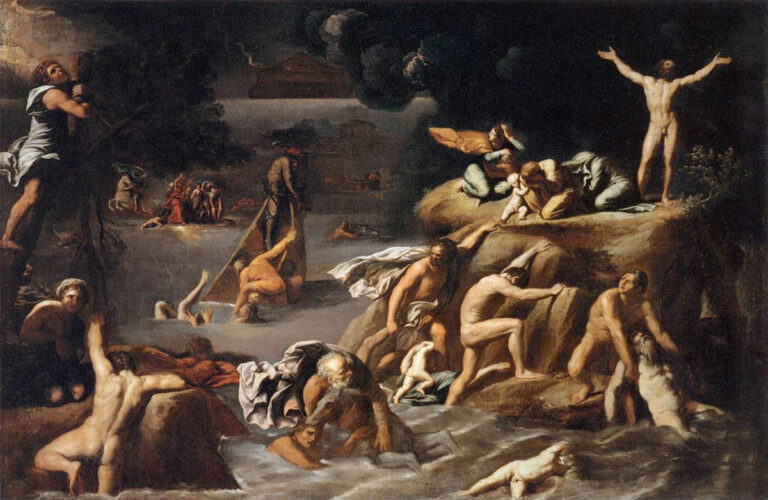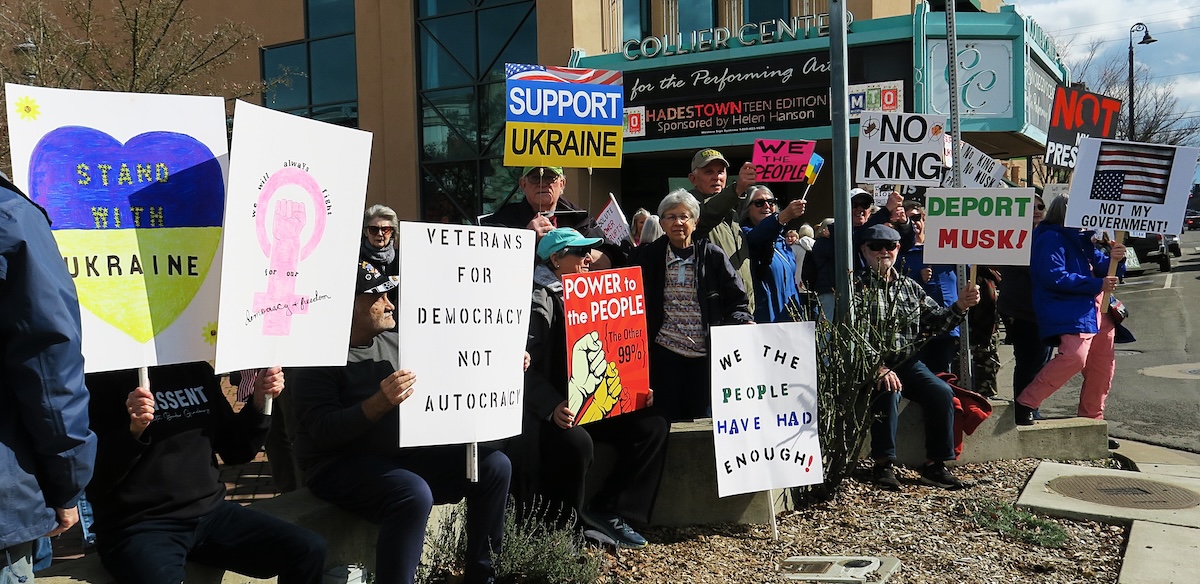By Jessica McKenzie | July 27, 2023 for Bulletin of Atomic Scientists
Another week, another catastrophic, record-setting, history-making flood, this time in Kentucky.
Preliminary assessments indicate rainfall in Graves County last week likely set a new record for most precipitation in a 24-hour period, with 11.28 inches of rain. This would make it yet another “1,000-year” flood event, which had, according to historical projections, less than a 0.1 percent chance of occurring in any given year. One of the towns that experienced flash flooding was Mayfield, a community still rebuilding from a 2021 tornado that killed 57 people.
This was just one of the 11 flash flood emergencies in as many days in the United States, according to Weather Channel meteorologist Heather Zons. These events have claimed multiple lives: 2-year-old Mattie Shiels, 9-month-old brother, Conrad, and their mother, Katie Seley drowned after getting swept away by flash flooding in Pennsylvania, during an event that killed at least four others. In New York earlier this month, 43-year-old Pamela Nugent was swept away trying to evacuate a flooded area; 63-year-old Stephen Davoll drowned in his home in Vermont.
Other catastrophic, deadly flooding events have occurred almost simultaneously around the globe. Just this weekend, 10 inches of rain fell on parts of Nova Scotia, Canada, which is about as much as the region experiences over a period of three months. Four people, including two children, are still missing.
Thousands of residents had to evacuate their homes in Delhi this month, after the Yamuna River swelled with rainwater. Flash floods and landslides have claimed at least 91 lives in northern India, and the waters are now lapping at the Taj Mahal.
Torrential rains, flash flooding, and landslides in South Korea have killed at least 46 people, with four more still missing.
Nearly two dozen cities in China experienced flooding this month; flooding claimed 15 lives (with four more people missing) in just one city, Chongqing, alone. At least 20,000 people have been displaced.
One begins to run out of ways to describe the death and destruction wrought by an onslaught of water. Lest reporters and readers become too numb, the Guardian compiled a shocking video montage of footage from around the globe that shows entire buildings collapsing and being swept away, and people clinging desperately to trees and cars on flooded roadways.
To help put these extreme events into context, the Bulletin reached out to Peter Gleick, noted water expert and the author of a new book titled The Three Ages of Water: Prehistoric Past, Imperiled Present, and a Hope for the Future.

This interview has been condensed and lightly edited.
Jessica McKenzie: I recently interviewed someone who actually moved to Vermont, from Montana to escape the wildfire smoke, because Vermont, as I’m sure you know, has been sort of pitched as a climate refuge, only for the state to experience both wildfire smoke and catastrophic flooding one after the other this year.
Peter Gleick: That’s a key point right off the bat. There is no place that is going to be safe from climate disruption as the climate changes worsen.
McKenzie: Right. And then there are all of these almost concurrent flooding events happening around the world right now, and it’s insane that these are like happening within days of each other.
Gleick: It IS crazy. The news in the last couple of months has just been relentless, nonstop, extreme events. It’s everything, everywhere, all at once. It’s flooding, heat waves, extraordinarily high surface temperatures on the oceans, record sea ice loss in the Antarctic and the Arctic. It’s an indication that the climate is spinning out of control.
McKenzie: So you’ve said this has to do with the hydrologic cycle speeding up. What is that and what does that mean?
Gleick: The hydrologic cycle, which I think of as a fundamental part of the climate cycle, is intensifying. It’s intensifying because by increasing greenhouse gas concentrations in the atmosphere, we trap more energy. By putting more energy into the atmosphere, we’re accelerating, intensifying the hydrologic cycle, we see more evaporation because temperatures are going up. More evaporation means more moisture in the atmosphere, more moisture in the atmosphere—it has to come down somewhere. And it’s coming down in intense events. Rather than an increase in the average of rainfall, we’re seeing an increase in the extremes of rainfall.
For example, in California over the last 100 years, average annual precipitation hasn’t really changed. It’s not raining more in California or less in California. But we’re getting more intense rainfall events. We’re getting more floods and more droughts. And the average is staying the same. There’s an old saying that you could have your head in the refrigerator and your feet in the oven and have a perfectly nice average temperature. But we’re getting more extremes. And that’s exactly what the observations are showing.
McKenzie: And is that holding true elsewhere? Outside of California as well?
Gleick: If you look at the data from the most recent US National Climate Assessment, which is done every few years by the Global Change Research Project (the USGCRP), it’s a national assessment of climate in the US. Precipitation events in the northeast, are becoming more intense. More rain is falling in shorter periods of time. That’s what we see right now in Vermont. It’s huge amounts of rain in a very short period of time. And that’s what contributes to flooding. If we had more rain on average, but it came in small events, we wouldn’t see the flooding, necessarily. But we’re seeing intensification of flooding, as a consequence of intensification of rainfall.
McKenzie: Is this the same thing as atmospheric rivers? Or are atmospheric rivers becoming more extreme now.
Gleick: So it’s a little different. Atmospheric rivers are a phenomenon really, in the western United States. They’re storm patterns that form in the Pacific and come ashore in intense bands. I mean, atmospheric rivers is a wonderful term. It’s very descriptive. California has always gotten rainfall in the winter in atmospheric rivers. We’re now getting more intense “rivers,” and more of them. So that’s what caused this year’s extreme events in California.
In California, the difference between a wet year and a dry year is really the number of atmospheric rivers we get. If more of them go further north in Washington, Oregon, and Canada, California gets a dry year. If more of these rivers come ashore in California, we’ll have a wet year, and maybe Oregon and Washington might have a dry year. And so that’s what atmospheric rivers mean for the Western US.
McKenzie: The flip side of this is drought. Can you elaborate a bit more on that relationship?
Gleick: This is a consequence that has long been projected by climate models and by atmospheric physics, that some of the major consequences of climate change, especially for water resources, would be an intensification of extremes at both ends of the spectrum, both droughts and floods. And that’s, again, what we’re now starting to see in the observations. We’re seeing more extreme events at both ends of the spectrum rather than necessarily a change in the average.
McKenzie: The flip side of this is drought. Can you elaborate a bit more on that relationship?
Gleick: This is a consequence that has long been projected by climate models and by atmospheric physics, that some of the major consequences of climate change, especially for water resources, would be an intensification of extremes at both ends of the spectrum, both droughts and floods. And that’s, again, what we’re now starting to see in the observations. We’re seeing more extreme events at both ends of the spectrum rather than necessarily a change in the average.
Precipitation in California—or runoff in California—the average hasn’t changed much, but we’re getting more extreme events. Five plus six plus seven averages six. One plus six plus 11 also averages six. If the average doesn’t change, you can still get a big change in extremes.
McKenzie: I was wondering if you could also talk a little bit about sort of the consequences of floods?
Gleick: There are enormous and diverse implications of flooding. Obviously, the most worrisome is loss of life. When flood events overwhelm the flood defenses that we build—the reservoirs, the levees—there’s also tremendous loss of property. That’s already beginning to cause serious disruptions in the flood insurance industry. More and more flood insurance companies are either not writing flood insurance policies, or they’re unable to pay the insurance that overwhelms their reserves.
An interesting consequence I just read about this morning is that massive flooding in India has damaged three water treatment plants. And they’re talking about having to ration drinking water, because the drinking water plants have been damaged by these floods. So ironically, in this case, an excess of water is causing a shortage of clean water supply. There are also ecosystem consequences, there’s damage to infrastructure like roadways and energy systems, and in agriculture, you get damage to crops. There are a whole wide range of flood consequences.
McKenzie: Often people [Editor’s note: often climate change skeptics] make the case that weather isn’t climate, but at this point it’s really impossible—or should be—to talk about extreme weather events without bringing in climate change. Can you elaborate on that idea?
Gleick: Weather and climate are related. The weather events that we’re seeing—extreme weather events—are symptoms of a changing climate. There are indications that climate change is influencing, not necessarily causing but influencing, extreme events. And this is a very important distinction that people sometimes don’t get. Climate scientists aren’t saying that this or that extreme event was “caused” by climate change. What we’re saying is that climate change is now influencing all weather on the planet. And it’s influencing the statistics of extreme events, it’s worsening the consequences of events that might have happened anyway, but now are worse.
We know that for every degree C of warming, the atmosphere holds 7–10 percent more water. And so you might have a rainfall event, but it would be worsened by the fact that it’s warmer and the fact that the atmosphere is holding more water and that the atmosphere has to deliver more water when it rains. And so weather and climate are not the same thing, but they’re intimately connected.
There was a new poll just released from the Public Policy Institute of California that shows the majority of people in California understand that extreme events are now affected by climate change, and that they personally have been affected by these extreme events. More than 70 percent of Californians think climate change is a real threat and ought to be addressed politically, which is a remarkable number. And I think that as more and more people experience these events, climate change becomes real to them.
We have to do two things, we have to both work harder to mitigate climate change by reducing greenhouse gas emissions; and yet we also have no choice but to work to adapt to those climate changes we can no longer avoid. It’s not one or the other, it’s both.
I talked about all these issues in my book, The Three Ages of Water. The close connections between water and energy, are close connections between water and climate. We know that it takes a lot of energy to collect and treat and process and use water resources. And we know it takes a lot of water to produce the energy that we use. And so anything we can do, to both reduce greenhouse gas emissions associated with our water system—by becoming more efficient, by using renewable energy, rather than fossil fuel energy—can reduce the contribution of our water system to the climate crisis by reducing greenhouse gas emissions associated with our water system.
But at the same time, we absolutely have to adapt our water systems to those climate changes we can no longer avoid. The example from India, where our water treatment plants are disrupted by climate disruption—most of our wastewater treatment plants are at the water’s edge. And many of our water treatment plants for drinking water, of course, are close to water resources. And the extent to which they’re vulnerable to climate change is an example of the kinds of adaptations we have to pursue. We have to make ourselves less vulnerable to the flooding we’re seeing, to the droughts that we’re experiencing. And that requires rethinking, remanaging, and redesigning the water systems that we built a century ago, but that really need to be updated for modern times.
McKenzie: The climate migrant I interviewed about his move to Vermont also works at an organization dedicated to preserving and restoring the native forests of New England. And he really hammered the point that it’s not just climate change, it’s also about the sort of choices that people have made to live in certain places, to build in certain ways. What are some better ways that we could be building and living near water to prevent these catastrophic impacts from happening when floods inevitably occur?
Gleick: One of the things I think we’ve learned in the last few decades is the incredible value of protecting natural ecosystems and restoring natural ecosystems. So we’re beginning to take down big dams. In the United States, we’ve taken down 1000 dams, mostly small, dangerous, uneconomic dams, but we’re beginning to take down larger and larger dams. But that also means we have to learn to live differently in floodplains.
In the past, we’ve built dams to protect against floods. And then we’ve built levees around our rivers and channelized our rivers. And then we built in the floodplains. We need to let the floodplains flood again. If the climate is going to cause more and more extreme flooding, which it is, we have to rethink the way we deal with floods and we have to let floods occur. They’re good ecologically anyway.
McKenzie: Right, flooding is how nutrients were once deposited across the floodplain creating good agricultural land.
Gleick: And it’s the way we recharge our groundwater. There are enormous ecological benefits to flooding. The economic consequences really come from the fact that we’ve built in vulnerable areas. If there’s one thing that our flood insurance companies are starting to tell us, it’s that we can no longer assume that we can build in floodplains and get flooded and then rebuild in the same place.
McKenzie: Is there anything else that you want to add?
Gleick: Even for someone like me, who’s studied this for a long time, the number and intensity of recent events has really been stunning. It’s been a shock. It’s a worrisome indication that climate changes are accelerating even more rapidly than we thought. And that those of us who have been warning about climate change for a long time, even we perhaps have been under-estimating the risk.
There is a growing awareness of the problem. There’s a growing understanding of the broad implications, but also the personal implications, of the problem. And in some ways, the biggest problem is just our politicians. It’s not the public, it’s not the media, it’s the politicians, who are still not dealing with the problem. That’s the biggest challenge in my mind.
There are things that we know we need to do, that we’re doing, but just not quickly enough, and we need to do all those things faster.


